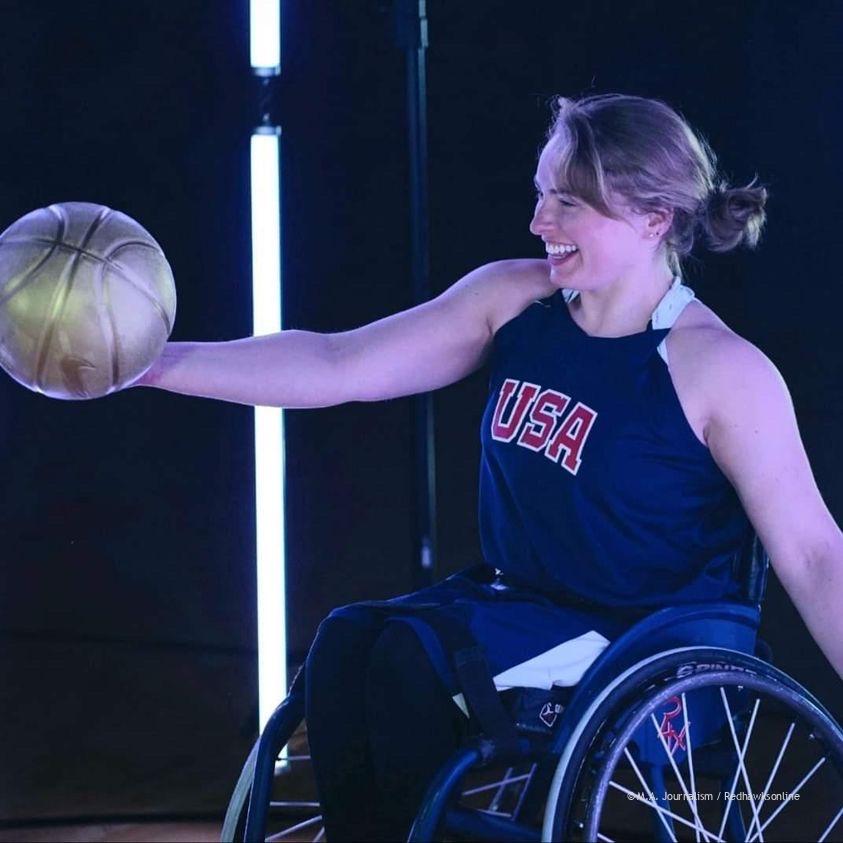Joshua Turek and Josie Aslakson urge kids with disabilities to get involved in athletics
“We were the underdogs going into the national tournament in 2016,” said Josie Aslakson, a bronze medalist for the United States women’s national wheelchair basketball team.”We were starting as a new team filled with lots of freshmen.”
Aslakson and her team had battled their way to the national wheelchair basketball championship and faced off against the highly ranked University of Illinois.
“We were unsure of how we would stack up against this team that had been around for years and years,” said Aslakson. “The senior squad which had international players who played for Team USA and Team Great Britain definitely was the greatest challenge to us the whole tournament. It was a tough fought battle but we eventually pulled through to win the tournament.” Adaptive sports are competitive or recreational sports for people with disabilities.
Adaptive sports often run similar to typical sports activities. However, certain modifications necessary for athletes with disabilities are allowed. According to Physiopedia, “Many of the sports use a classification system that puts athletes with physical challenges on an even playing field with each other. For instance, athletes with hemiplegia competing in track events are usually classified T37. The T is for track (F37 is for field events), the 3 represents a cerebral palsy classification and the 7 specifies an athlete with weakness/spasticity on one side of the body. The use of a detailed classification system based on type of disability allows for a more fair competition.”
There is a wide range of adaptive sports out there including archery, bowling, fencing, fishing, and hunting. Aslakson, who was in a car accident at the age of 5 leaving the bottom half of her body paralyzed, was given an opportunity to try many different adaptive sports.
“I found a connection through the Courage Center in Golden Valley to start trying adaptive sports,” said Aslakson. “Wheelchair basketball definitely stood out to me.”
Although Aslakson was fascinated with basketball, the relaxed sport of archery called to Aslakson first. It wasn’t until Aslakson was 13 years old before she fully gave wheelchair basketball a try.
“A wheelchair basketball coach saw me and thought that I would enjoy basketball a lot more than archery,” said Aslakson. “When I gave it a shot I immediately fell in love with the sport. The team element, thrill, and excitement was such a dramatic change from archery.”
Joshua Turek, a bronze and two-time gold medalist for the United States men’s national wheelchair basketball team was born with spina bifida, a condition that left him paralyzed from the knees down. While searching for different adaptive sports, Turek discovered wheelchair basketball at a young age.
“I found wheelchair basketball at 12 years old,” said Turek. “There was a local sports organization that put on a free summer camp for disabled children, and exposed us to a variety of sports, and one of which was wheelchair basketball. As soon as I played it, I immediately fell in love with it.”
Although both athletes discovered and fell in love with their sport at a young age, they agree that adaptive sports can sometimes be difficult to get into.
“There is a financial hardship that comes with getting involved in adaptive athletics,” said Aslakson. “There is a lot of money required to pay for much more equipment than you would normally have to just to play able-bodied basketball. For example, where you just need a pair of shoes, you’re now paying for a sports chair and all the equipment that comes with that.”
The price that adaptive sports requires can sometimes discourage families early on. This affects the children from not being able to try these sports and getting involved. In addition to financial issues are problems with social media and how kids view themselves.
“There is an underlying problem with how social media is affecting the motivation of athletes, especially young athletes that may be wanting to get into adaptive sports,” said Aslakson. “It’s very common nowadays and when I was a kid, too, but especially now that social media is so popular, many kids are discouraged. Kids see all of these superstars around them posting on social media and kids think that they can never get to that point because of their disability.”
Experiences with bullying are also a factor that affects the motivation of trying adaptive sports for kids with disabilities.
“A big struggle for me getting into sports was bullying,” said Turek. “Getting made fun of and constantly receiving criticism for something we can’t change really can impact us both as an athlete and as a person. But finding something that I loved like wheelchair basketball helped me take my attention away from all of this.”
With Turek and Aslakson dealing with obstacles from a young age, both athletes deliver the same message that hard work and commitment are what drives athletes to push through the hardships.
“There’s a whole backstory to adaptive sports athletes that aren’t shown,” said Aslakson. “Going through constant criticism is already tough on its own. But then there is the endless work that goes into mastering the sport and technique. I think a lot of the younger generations are getting more discouraged if they don’t have success right away because they’re seeing a lot of us USA athletes getting promoted. But the kids just need to know that getting involved and trying their best is already a huge accomplishment on its own.”
Turek agrees that getting involved and giving your all is a huge success.
“If you put in the work, the results will come,” said Turek. “If you have a single-minded focus, you will truly fall in love with the process of becoming great. We’ve all got greatness within us; you just need to try hard to pull it out.”

